Report: Safety Risks and Reliability in a Scrap Metal Recycling Plant
VerifiedAdded on 2020/03/16
|12
|3612
|28
Report
AI Summary
This report provides a detailed analysis of safety risks and reliability considerations within a scrap metal recycling plant. It begins with an introduction emphasizing the importance of integrating safety and reliability from the design phase. The report identifies various hazards, including human, environmental, fire/explosion, and physical hazards, associated with the different stages of the recycling process, such as loading, sorting, transportation, pretreatment, and conversion. It highlights specific risks like flying metal pieces, noise hazards, and machinery-related dangers. The report then delves into risk assessment and mitigation measures, proposing solutions such as the use of personal protective equipment (PPE), regular equipment maintenance, risk management guidelines, and operator training. Furthermore, it addresses environmental hazards like metal dust and particle emissions, suggesting engineering solutions like dust cleaning systems, sensors, and ventilation to prevent explosions and inhalation risks. The report underscores the need for comprehensive safety protocols and employee training to ensure a safe working environment.
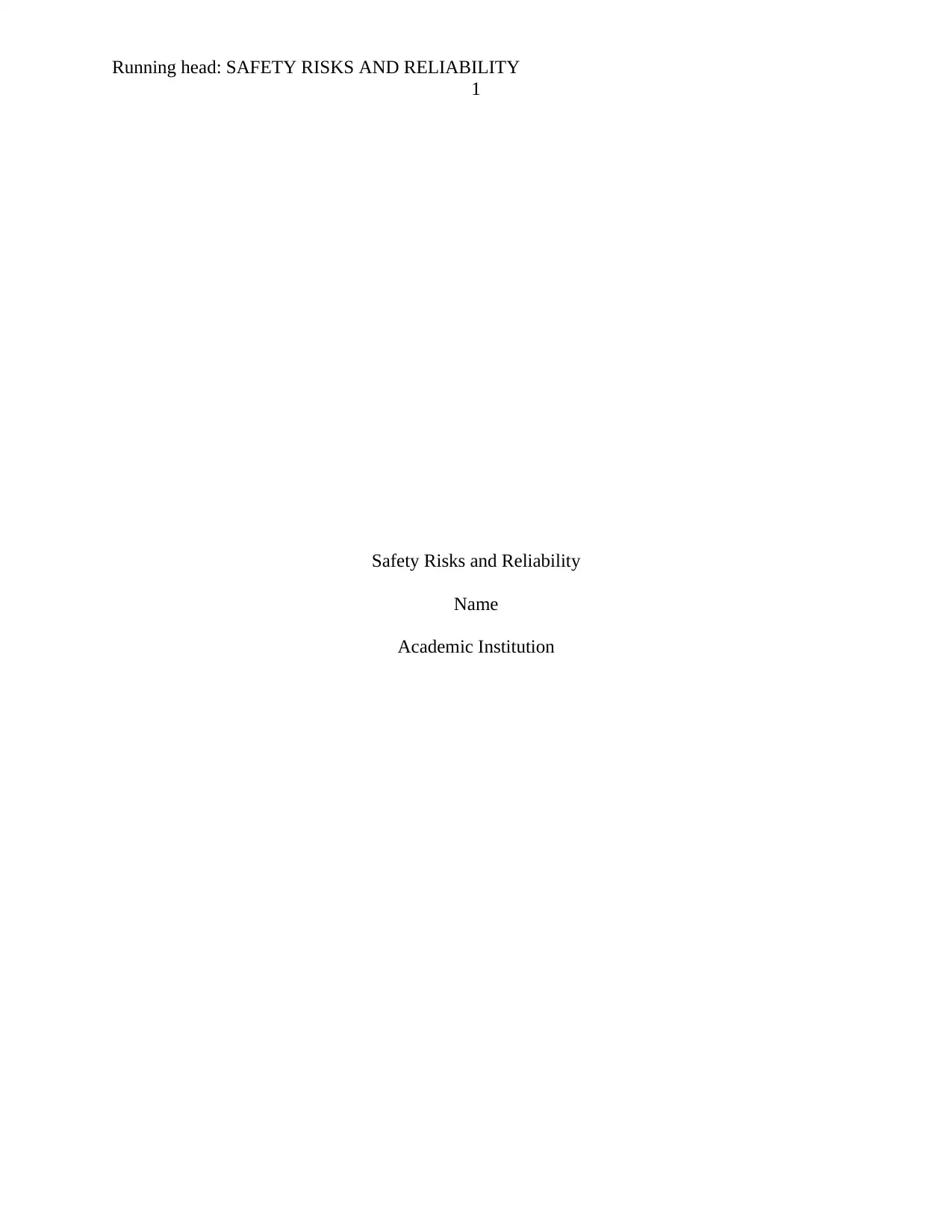
Running head: SAFETY RISKS AND RELIABILITY
1
Safety Risks and Reliability
Name
Academic Institution
1
Safety Risks and Reliability
Name
Academic Institution
Paraphrase This Document
Need a fresh take? Get an instant paraphrase of this document with our AI Paraphraser
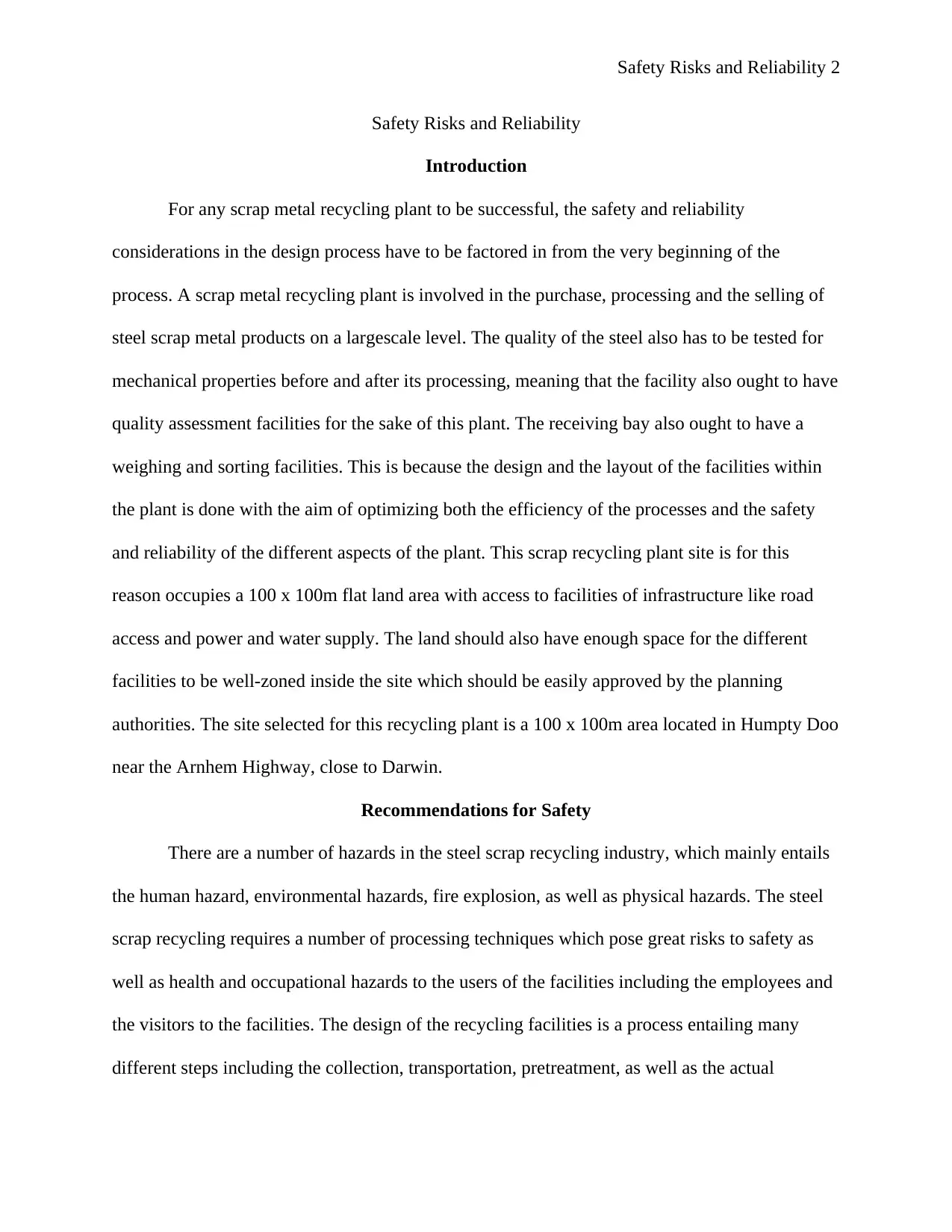
Safety Risks and Reliability 2
Safety Risks and Reliability
Introduction
For any scrap metal recycling plant to be successful, the safety and reliability
considerations in the design process have to be factored in from the very beginning of the
process. A scrap metal recycling plant is involved in the purchase, processing and the selling of
steel scrap metal products on a largescale level. The quality of the steel also has to be tested for
mechanical properties before and after its processing, meaning that the facility also ought to have
quality assessment facilities for the sake of this plant. The receiving bay also ought to have a
weighing and sorting facilities. This is because the design and the layout of the facilities within
the plant is done with the aim of optimizing both the efficiency of the processes and the safety
and reliability of the different aspects of the plant. This scrap recycling plant site is for this
reason occupies a 100 x 100m flat land area with access to facilities of infrastructure like road
access and power and water supply. The land should also have enough space for the different
facilities to be well-zoned inside the site which should be easily approved by the planning
authorities. The site selected for this recycling plant is a 100 x 100m area located in Humpty Doo
near the Arnhem Highway, close to Darwin.
Recommendations for Safety
There are a number of hazards in the steel scrap recycling industry, which mainly entails
the human hazard, environmental hazards, fire explosion, as well as physical hazards. The steel
scrap recycling requires a number of processing techniques which pose great risks to safety as
well as health and occupational hazards to the users of the facilities including the employees and
the visitors to the facilities. The design of the recycling facilities is a process entailing many
different steps including the collection, transportation, pretreatment, as well as the actual
Safety Risks and Reliability
Introduction
For any scrap metal recycling plant to be successful, the safety and reliability
considerations in the design process have to be factored in from the very beginning of the
process. A scrap metal recycling plant is involved in the purchase, processing and the selling of
steel scrap metal products on a largescale level. The quality of the steel also has to be tested for
mechanical properties before and after its processing, meaning that the facility also ought to have
quality assessment facilities for the sake of this plant. The receiving bay also ought to have a
weighing and sorting facilities. This is because the design and the layout of the facilities within
the plant is done with the aim of optimizing both the efficiency of the processes and the safety
and reliability of the different aspects of the plant. This scrap recycling plant site is for this
reason occupies a 100 x 100m flat land area with access to facilities of infrastructure like road
access and power and water supply. The land should also have enough space for the different
facilities to be well-zoned inside the site which should be easily approved by the planning
authorities. The site selected for this recycling plant is a 100 x 100m area located in Humpty Doo
near the Arnhem Highway, close to Darwin.
Recommendations for Safety
There are a number of hazards in the steel scrap recycling industry, which mainly entails
the human hazard, environmental hazards, fire explosion, as well as physical hazards. The steel
scrap recycling requires a number of processing techniques which pose great risks to safety as
well as health and occupational hazards to the users of the facilities including the employees and
the visitors to the facilities. The design of the recycling facilities is a process entailing many
different steps including the collection, transportation, pretreatment, as well as the actual
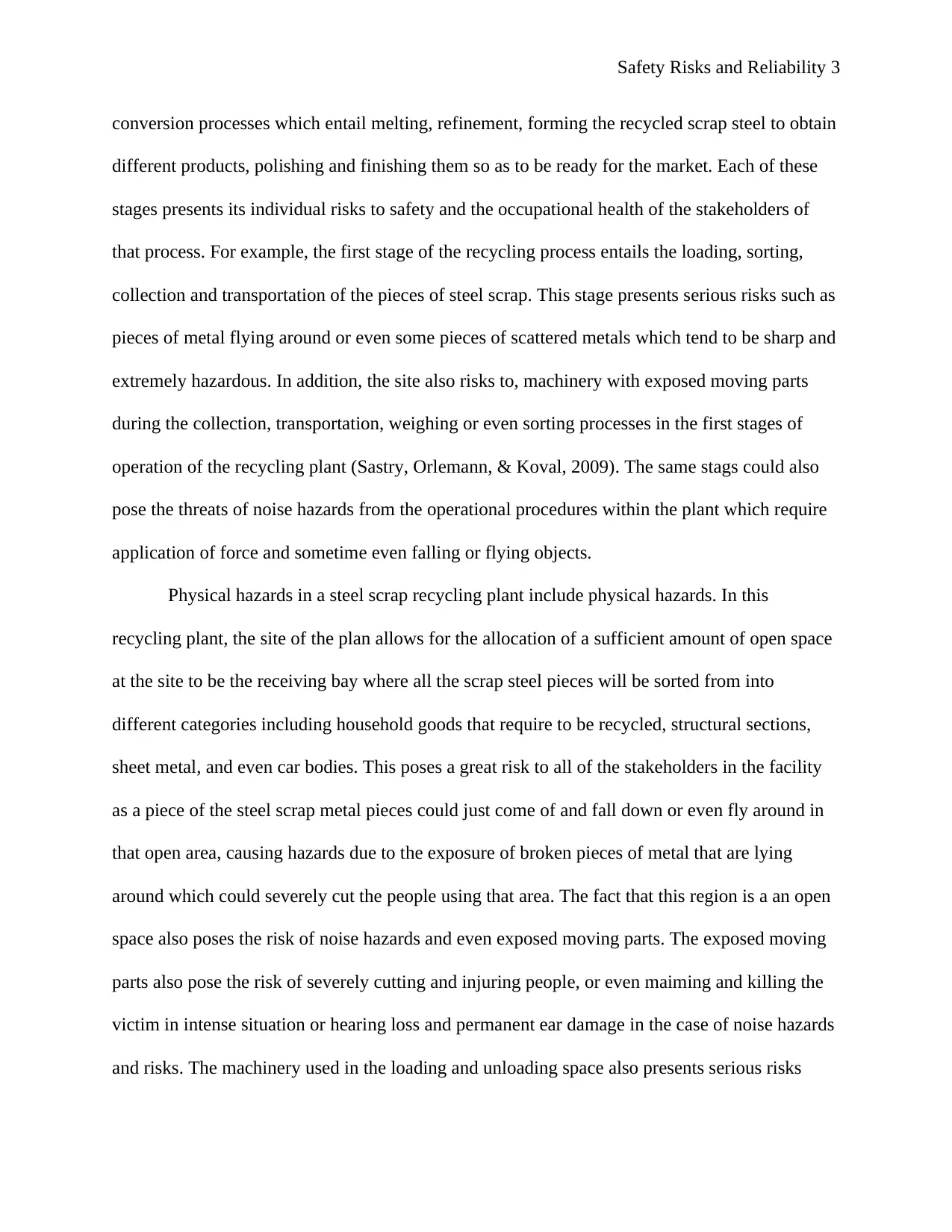
Safety Risks and Reliability 3
conversion processes which entail melting, refinement, forming the recycled scrap steel to obtain
different products, polishing and finishing them so as to be ready for the market. Each of these
stages presents its individual risks to safety and the occupational health of the stakeholders of
that process. For example, the first stage of the recycling process entails the loading, sorting,
collection and transportation of the pieces of steel scrap. This stage presents serious risks such as
pieces of metal flying around or even some pieces of scattered metals which tend to be sharp and
extremely hazardous. In addition, the site also risks to, machinery with exposed moving parts
during the collection, transportation, weighing or even sorting processes in the first stages of
operation of the recycling plant (Sastry, Orlemann, & Koval, 2009). The same stags could also
pose the threats of noise hazards from the operational procedures within the plant which require
application of force and sometime even falling or flying objects.
Physical hazards in a steel scrap recycling plant include physical hazards. In this
recycling plant, the site of the plan allows for the allocation of a sufficient amount of open space
at the site to be the receiving bay where all the scrap steel pieces will be sorted from into
different categories including household goods that require to be recycled, structural sections,
sheet metal, and even car bodies. This poses a great risk to all of the stakeholders in the facility
as a piece of the steel scrap metal pieces could just come of and fall down or even fly around in
that open area, causing hazards due to the exposure of broken pieces of metal that are lying
around which could severely cut the people using that area. The fact that this region is a an open
space also poses the risk of noise hazards and even exposed moving parts. The exposed moving
parts also pose the risk of severely cutting and injuring people, or even maiming and killing the
victim in intense situation or hearing loss and permanent ear damage in the case of noise hazards
and risks. The machinery used in the loading and unloading space also presents serious risks
conversion processes which entail melting, refinement, forming the recycled scrap steel to obtain
different products, polishing and finishing them so as to be ready for the market. Each of these
stages presents its individual risks to safety and the occupational health of the stakeholders of
that process. For example, the first stage of the recycling process entails the loading, sorting,
collection and transportation of the pieces of steel scrap. This stage presents serious risks such as
pieces of metal flying around or even some pieces of scattered metals which tend to be sharp and
extremely hazardous. In addition, the site also risks to, machinery with exposed moving parts
during the collection, transportation, weighing or even sorting processes in the first stages of
operation of the recycling plant (Sastry, Orlemann, & Koval, 2009). The same stags could also
pose the threats of noise hazards from the operational procedures within the plant which require
application of force and sometime even falling or flying objects.
Physical hazards in a steel scrap recycling plant include physical hazards. In this
recycling plant, the site of the plan allows for the allocation of a sufficient amount of open space
at the site to be the receiving bay where all the scrap steel pieces will be sorted from into
different categories including household goods that require to be recycled, structural sections,
sheet metal, and even car bodies. This poses a great risk to all of the stakeholders in the facility
as a piece of the steel scrap metal pieces could just come of and fall down or even fly around in
that open area, causing hazards due to the exposure of broken pieces of metal that are lying
around which could severely cut the people using that area. The fact that this region is a an open
space also poses the risk of noise hazards and even exposed moving parts. The exposed moving
parts also pose the risk of severely cutting and injuring people, or even maiming and killing the
victim in intense situation or hearing loss and permanent ear damage in the case of noise hazards
and risks. The machinery used in the loading and unloading space also presents serious risks
⊘ This is a preview!⊘
Do you want full access?
Subscribe today to unlock all pages.

Trusted by 1+ million students worldwide
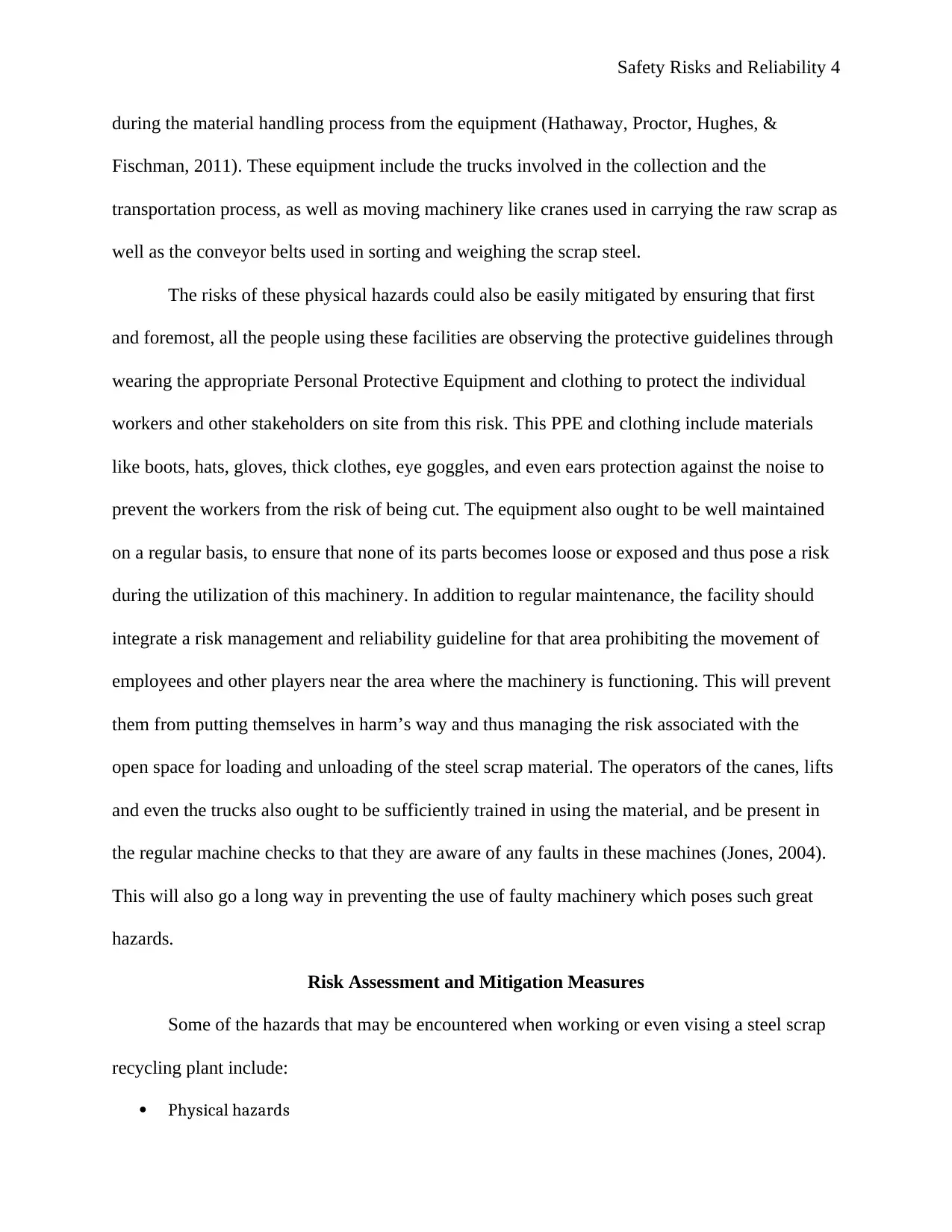
Safety Risks and Reliability 4
during the material handling process from the equipment (Hathaway, Proctor, Hughes, &
Fischman, 2011). These equipment include the trucks involved in the collection and the
transportation process, as well as moving machinery like cranes used in carrying the raw scrap as
well as the conveyor belts used in sorting and weighing the scrap steel.
The risks of these physical hazards could also be easily mitigated by ensuring that first
and foremost, all the people using these facilities are observing the protective guidelines through
wearing the appropriate Personal Protective Equipment and clothing to protect the individual
workers and other stakeholders on site from this risk. This PPE and clothing include materials
like boots, hats, gloves, thick clothes, eye goggles, and even ears protection against the noise to
prevent the workers from the risk of being cut. The equipment also ought to be well maintained
on a regular basis, to ensure that none of its parts becomes loose or exposed and thus pose a risk
during the utilization of this machinery. In addition to regular maintenance, the facility should
integrate a risk management and reliability guideline for that area prohibiting the movement of
employees and other players near the area where the machinery is functioning. This will prevent
them from putting themselves in harm’s way and thus managing the risk associated with the
open space for loading and unloading of the steel scrap material. The operators of the canes, lifts
and even the trucks also ought to be sufficiently trained in using the material, and be present in
the regular machine checks to that they are aware of any faults in these machines (Jones, 2004).
This will also go a long way in preventing the use of faulty machinery which poses such great
hazards.
Risk Assessment and Mitigation Measures
Some of the hazards that may be encountered when working or even vising a steel scrap
recycling plant include:
Physical hazards
during the material handling process from the equipment (Hathaway, Proctor, Hughes, &
Fischman, 2011). These equipment include the trucks involved in the collection and the
transportation process, as well as moving machinery like cranes used in carrying the raw scrap as
well as the conveyor belts used in sorting and weighing the scrap steel.
The risks of these physical hazards could also be easily mitigated by ensuring that first
and foremost, all the people using these facilities are observing the protective guidelines through
wearing the appropriate Personal Protective Equipment and clothing to protect the individual
workers and other stakeholders on site from this risk. This PPE and clothing include materials
like boots, hats, gloves, thick clothes, eye goggles, and even ears protection against the noise to
prevent the workers from the risk of being cut. The equipment also ought to be well maintained
on a regular basis, to ensure that none of its parts becomes loose or exposed and thus pose a risk
during the utilization of this machinery. In addition to regular maintenance, the facility should
integrate a risk management and reliability guideline for that area prohibiting the movement of
employees and other players near the area where the machinery is functioning. This will prevent
them from putting themselves in harm’s way and thus managing the risk associated with the
open space for loading and unloading of the steel scrap material. The operators of the canes, lifts
and even the trucks also ought to be sufficiently trained in using the material, and be present in
the regular machine checks to that they are aware of any faults in these machines (Jones, 2004).
This will also go a long way in preventing the use of faulty machinery which poses such great
hazards.
Risk Assessment and Mitigation Measures
Some of the hazards that may be encountered when working or even vising a steel scrap
recycling plant include:
Physical hazards
Paraphrase This Document
Need a fresh take? Get an instant paraphrase of this document with our AI Paraphraser
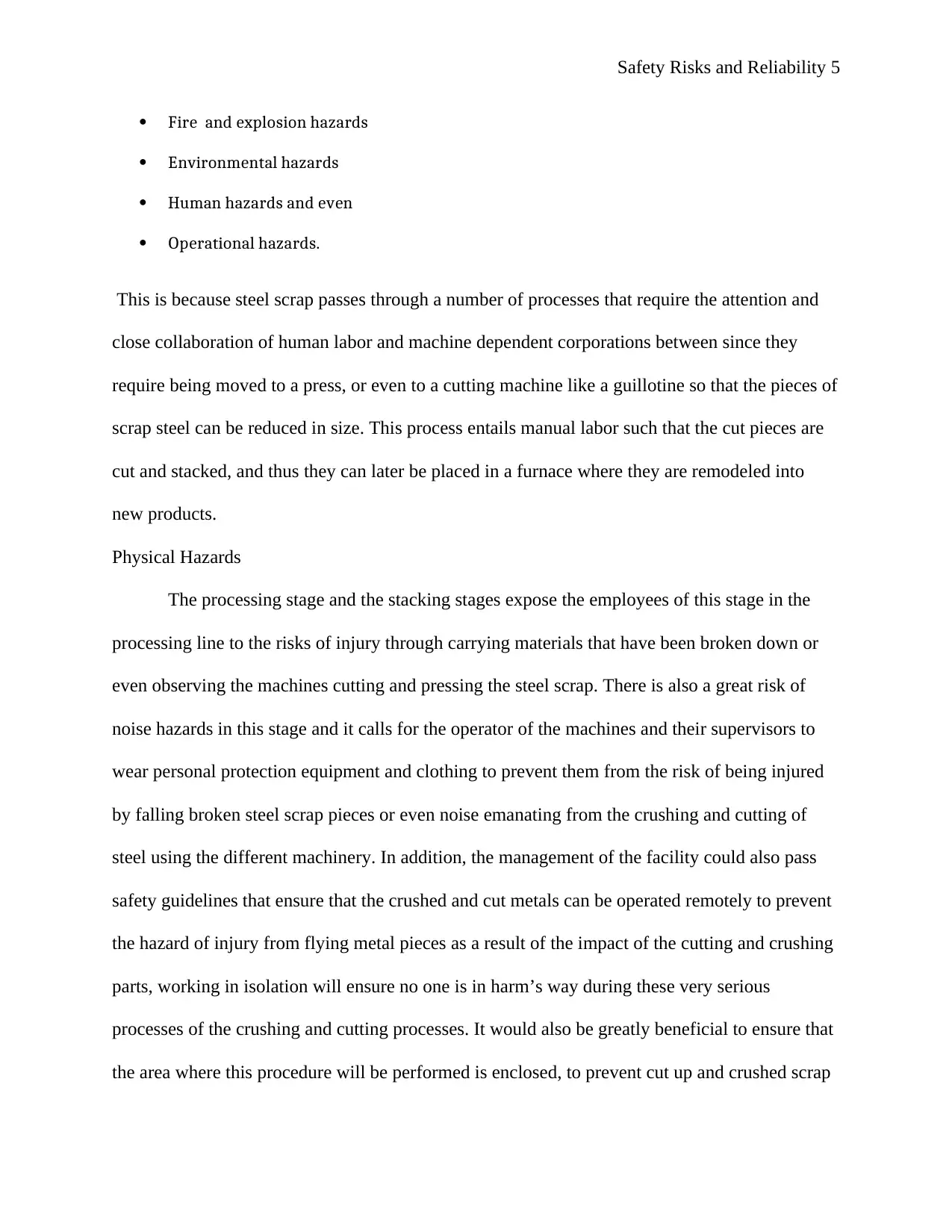
Safety Risks and Reliability 5
Fire and explosion hazards
Environmental hazards
Human hazards and even
Operational hazards.
This is because steel scrap passes through a number of processes that require the attention and
close collaboration of human labor and machine dependent corporations between since they
require being moved to a press, or even to a cutting machine like a guillotine so that the pieces of
scrap steel can be reduced in size. This process entails manual labor such that the cut pieces are
cut and stacked, and thus they can later be placed in a furnace where they are remodeled into
new products.
Physical Hazards
The processing stage and the stacking stages expose the employees of this stage in the
processing line to the risks of injury through carrying materials that have been broken down or
even observing the machines cutting and pressing the steel scrap. There is also a great risk of
noise hazards in this stage and it calls for the operator of the machines and their supervisors to
wear personal protection equipment and clothing to prevent them from the risk of being injured
by falling broken steel scrap pieces or even noise emanating from the crushing and cutting of
steel using the different machinery. In addition, the management of the facility could also pass
safety guidelines that ensure that the crushed and cut metals can be operated remotely to prevent
the hazard of injury from flying metal pieces as a result of the impact of the cutting and crushing
parts, working in isolation will ensure no one is in harm’s way during these very serious
processes of the crushing and cutting processes. It would also be greatly beneficial to ensure that
the area where this procedure will be performed is enclosed, to prevent cut up and crushed scrap
Fire and explosion hazards
Environmental hazards
Human hazards and even
Operational hazards.
This is because steel scrap passes through a number of processes that require the attention and
close collaboration of human labor and machine dependent corporations between since they
require being moved to a press, or even to a cutting machine like a guillotine so that the pieces of
scrap steel can be reduced in size. This process entails manual labor such that the cut pieces are
cut and stacked, and thus they can later be placed in a furnace where they are remodeled into
new products.
Physical Hazards
The processing stage and the stacking stages expose the employees of this stage in the
processing line to the risks of injury through carrying materials that have been broken down or
even observing the machines cutting and pressing the steel scrap. There is also a great risk of
noise hazards in this stage and it calls for the operator of the machines and their supervisors to
wear personal protection equipment and clothing to prevent them from the risk of being injured
by falling broken steel scrap pieces or even noise emanating from the crushing and cutting of
steel using the different machinery. In addition, the management of the facility could also pass
safety guidelines that ensure that the crushed and cut metals can be operated remotely to prevent
the hazard of injury from flying metal pieces as a result of the impact of the cutting and crushing
parts, working in isolation will ensure no one is in harm’s way during these very serious
processes of the crushing and cutting processes. It would also be greatly beneficial to ensure that
the area where this procedure will be performed is enclosed, to prevent cut up and crushed scrap
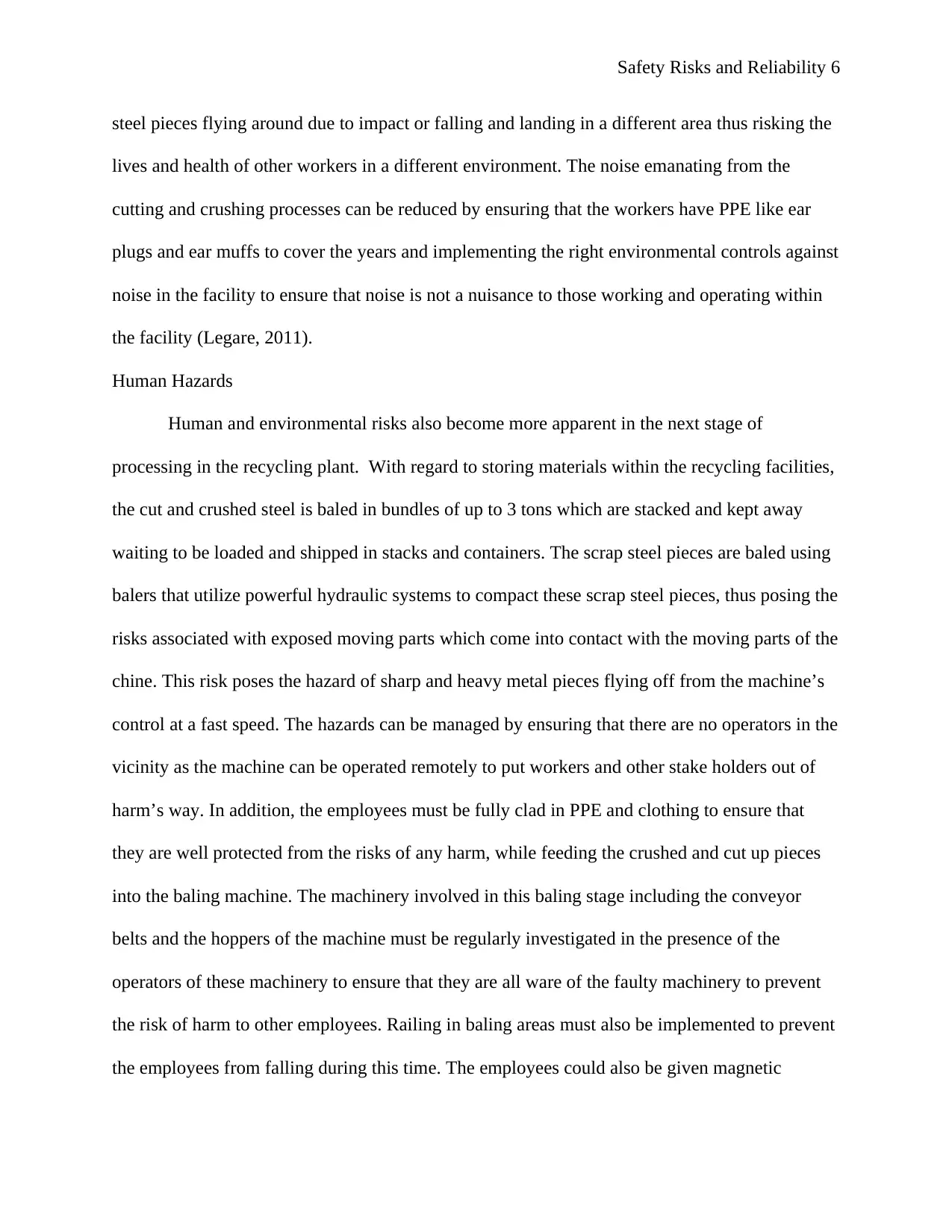
Safety Risks and Reliability 6
steel pieces flying around due to impact or falling and landing in a different area thus risking the
lives and health of other workers in a different environment. The noise emanating from the
cutting and crushing processes can be reduced by ensuring that the workers have PPE like ear
plugs and ear muffs to cover the years and implementing the right environmental controls against
noise in the facility to ensure that noise is not a nuisance to those working and operating within
the facility (Legare, 2011).
Human Hazards
Human and environmental risks also become more apparent in the next stage of
processing in the recycling plant. With regard to storing materials within the recycling facilities,
the cut and crushed steel is baled in bundles of up to 3 tons which are stacked and kept away
waiting to be loaded and shipped in stacks and containers. The scrap steel pieces are baled using
balers that utilize powerful hydraulic systems to compact these scrap steel pieces, thus posing the
risks associated with exposed moving parts which come into contact with the moving parts of the
chine. This risk poses the hazard of sharp and heavy metal pieces flying off from the machine’s
control at a fast speed. The hazards can be managed by ensuring that there are no operators in the
vicinity as the machine can be operated remotely to put workers and other stake holders out of
harm’s way. In addition, the employees must be fully clad in PPE and clothing to ensure that
they are well protected from the risks of any harm, while feeding the crushed and cut up pieces
into the baling machine. The machinery involved in this baling stage including the conveyor
belts and the hoppers of the machine must be regularly investigated in the presence of the
operators of these machinery to ensure that they are all ware of the faulty machinery to prevent
the risk of harm to other employees. Railing in baling areas must also be implemented to prevent
the employees from falling during this time. The employees could also be given magnetic
steel pieces flying around due to impact or falling and landing in a different area thus risking the
lives and health of other workers in a different environment. The noise emanating from the
cutting and crushing processes can be reduced by ensuring that the workers have PPE like ear
plugs and ear muffs to cover the years and implementing the right environmental controls against
noise in the facility to ensure that noise is not a nuisance to those working and operating within
the facility (Legare, 2011).
Human Hazards
Human and environmental risks also become more apparent in the next stage of
processing in the recycling plant. With regard to storing materials within the recycling facilities,
the cut and crushed steel is baled in bundles of up to 3 tons which are stacked and kept away
waiting to be loaded and shipped in stacks and containers. The scrap steel pieces are baled using
balers that utilize powerful hydraulic systems to compact these scrap steel pieces, thus posing the
risks associated with exposed moving parts which come into contact with the moving parts of the
chine. This risk poses the hazard of sharp and heavy metal pieces flying off from the machine’s
control at a fast speed. The hazards can be managed by ensuring that there are no operators in the
vicinity as the machine can be operated remotely to put workers and other stake holders out of
harm’s way. In addition, the employees must be fully clad in PPE and clothing to ensure that
they are well protected from the risks of any harm, while feeding the crushed and cut up pieces
into the baling machine. The machinery involved in this baling stage including the conveyor
belts and the hoppers of the machine must be regularly investigated in the presence of the
operators of these machinery to ensure that they are all ware of the faulty machinery to prevent
the risk of harm to other employees. Railing in baling areas must also be implemented to prevent
the employees from falling during this time. The employees could also be given magnetic
⊘ This is a preview!⊘
Do you want full access?
Subscribe today to unlock all pages.

Trusted by 1+ million students worldwide
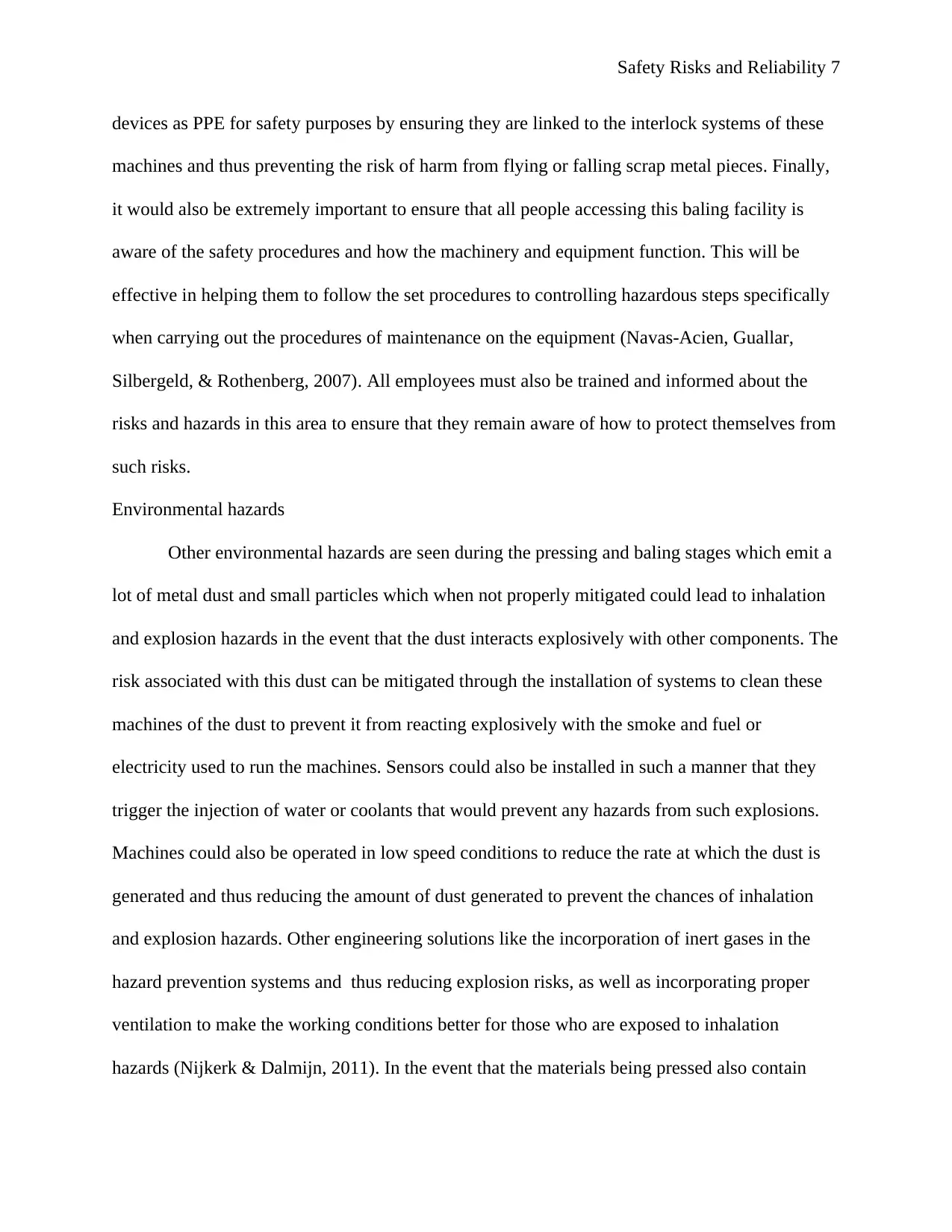
Safety Risks and Reliability 7
devices as PPE for safety purposes by ensuring they are linked to the interlock systems of these
machines and thus preventing the risk of harm from flying or falling scrap metal pieces. Finally,
it would also be extremely important to ensure that all people accessing this baling facility is
aware of the safety procedures and how the machinery and equipment function. This will be
effective in helping them to follow the set procedures to controlling hazardous steps specifically
when carrying out the procedures of maintenance on the equipment (Navas-Acien, Guallar,
Silbergeld, & Rothenberg, 2007). All employees must also be trained and informed about the
risks and hazards in this area to ensure that they remain aware of how to protect themselves from
such risks.
Environmental hazards
Other environmental hazards are seen during the pressing and baling stages which emit a
lot of metal dust and small particles which when not properly mitigated could lead to inhalation
and explosion hazards in the event that the dust interacts explosively with other components. The
risk associated with this dust can be mitigated through the installation of systems to clean these
machines of the dust to prevent it from reacting explosively with the smoke and fuel or
electricity used to run the machines. Sensors could also be installed in such a manner that they
trigger the injection of water or coolants that would prevent any hazards from such explosions.
Machines could also be operated in low speed conditions to reduce the rate at which the dust is
generated and thus reducing the amount of dust generated to prevent the chances of inhalation
and explosion hazards. Other engineering solutions like the incorporation of inert gases in the
hazard prevention systems and thus reducing explosion risks, as well as incorporating proper
ventilation to make the working conditions better for those who are exposed to inhalation
hazards (Nijkerk & Dalmijn, 2011). In the event that the materials being pressed also contain
devices as PPE for safety purposes by ensuring they are linked to the interlock systems of these
machines and thus preventing the risk of harm from flying or falling scrap metal pieces. Finally,
it would also be extremely important to ensure that all people accessing this baling facility is
aware of the safety procedures and how the machinery and equipment function. This will be
effective in helping them to follow the set procedures to controlling hazardous steps specifically
when carrying out the procedures of maintenance on the equipment (Navas-Acien, Guallar,
Silbergeld, & Rothenberg, 2007). All employees must also be trained and informed about the
risks and hazards in this area to ensure that they remain aware of how to protect themselves from
such risks.
Environmental hazards
Other environmental hazards are seen during the pressing and baling stages which emit a
lot of metal dust and small particles which when not properly mitigated could lead to inhalation
and explosion hazards in the event that the dust interacts explosively with other components. The
risk associated with this dust can be mitigated through the installation of systems to clean these
machines of the dust to prevent it from reacting explosively with the smoke and fuel or
electricity used to run the machines. Sensors could also be installed in such a manner that they
trigger the injection of water or coolants that would prevent any hazards from such explosions.
Machines could also be operated in low speed conditions to reduce the rate at which the dust is
generated and thus reducing the amount of dust generated to prevent the chances of inhalation
and explosion hazards. Other engineering solutions like the incorporation of inert gases in the
hazard prevention systems and thus reducing explosion risks, as well as incorporating proper
ventilation to make the working conditions better for those who are exposed to inhalation
hazards (Nijkerk & Dalmijn, 2011). In the event that the materials being pressed also contain
Paraphrase This Document
Need a fresh take? Get an instant paraphrase of this document with our AI Paraphraser
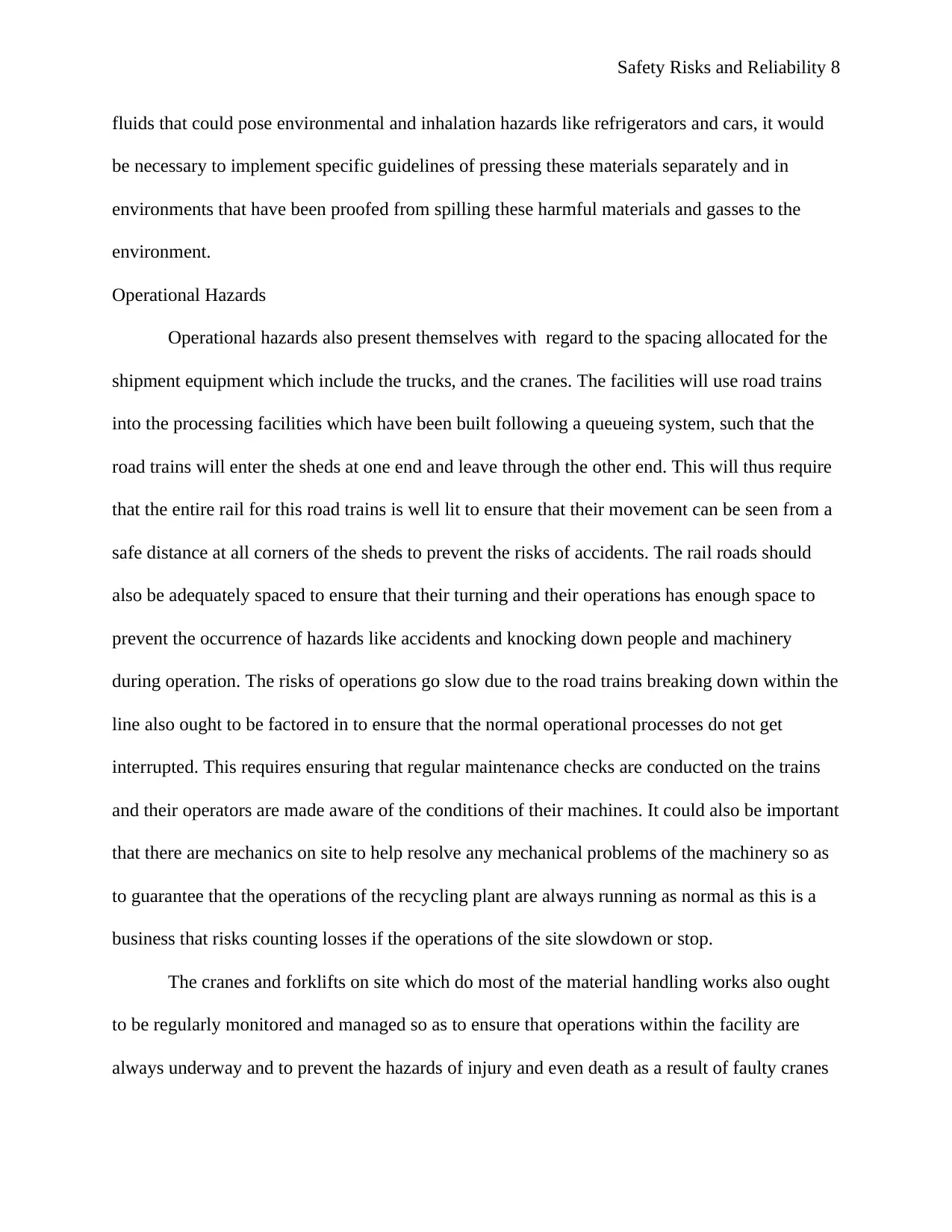
Safety Risks and Reliability 8
fluids that could pose environmental and inhalation hazards like refrigerators and cars, it would
be necessary to implement specific guidelines of pressing these materials separately and in
environments that have been proofed from spilling these harmful materials and gasses to the
environment.
Operational Hazards
Operational hazards also present themselves with regard to the spacing allocated for the
shipment equipment which include the trucks, and the cranes. The facilities will use road trains
into the processing facilities which have been built following a queueing system, such that the
road trains will enter the sheds at one end and leave through the other end. This will thus require
that the entire rail for this road trains is well lit to ensure that their movement can be seen from a
safe distance at all corners of the sheds to prevent the risks of accidents. The rail roads should
also be adequately spaced to ensure that their turning and their operations has enough space to
prevent the occurrence of hazards like accidents and knocking down people and machinery
during operation. The risks of operations go slow due to the road trains breaking down within the
line also ought to be factored in to ensure that the normal operational processes do not get
interrupted. This requires ensuring that regular maintenance checks are conducted on the trains
and their operators are made aware of the conditions of their machines. It could also be important
that there are mechanics on site to help resolve any mechanical problems of the machinery so as
to guarantee that the operations of the recycling plant are always running as normal as this is a
business that risks counting losses if the operations of the site slowdown or stop.
The cranes and forklifts on site which do most of the material handling works also ought
to be regularly monitored and managed so as to ensure that operations within the facility are
always underway and to prevent the hazards of injury and even death as a result of faulty cranes
fluids that could pose environmental and inhalation hazards like refrigerators and cars, it would
be necessary to implement specific guidelines of pressing these materials separately and in
environments that have been proofed from spilling these harmful materials and gasses to the
environment.
Operational Hazards
Operational hazards also present themselves with regard to the spacing allocated for the
shipment equipment which include the trucks, and the cranes. The facilities will use road trains
into the processing facilities which have been built following a queueing system, such that the
road trains will enter the sheds at one end and leave through the other end. This will thus require
that the entire rail for this road trains is well lit to ensure that their movement can be seen from a
safe distance at all corners of the sheds to prevent the risks of accidents. The rail roads should
also be adequately spaced to ensure that their turning and their operations has enough space to
prevent the occurrence of hazards like accidents and knocking down people and machinery
during operation. The risks of operations go slow due to the road trains breaking down within the
line also ought to be factored in to ensure that the normal operational processes do not get
interrupted. This requires ensuring that regular maintenance checks are conducted on the trains
and their operators are made aware of the conditions of their machines. It could also be important
that there are mechanics on site to help resolve any mechanical problems of the machinery so as
to guarantee that the operations of the recycling plant are always running as normal as this is a
business that risks counting losses if the operations of the site slowdown or stop.
The cranes and forklifts on site which do most of the material handling works also ought
to be regularly monitored and managed so as to ensure that operations within the facility are
always underway and to prevent the hazards of injury and even death as a result of faulty cranes
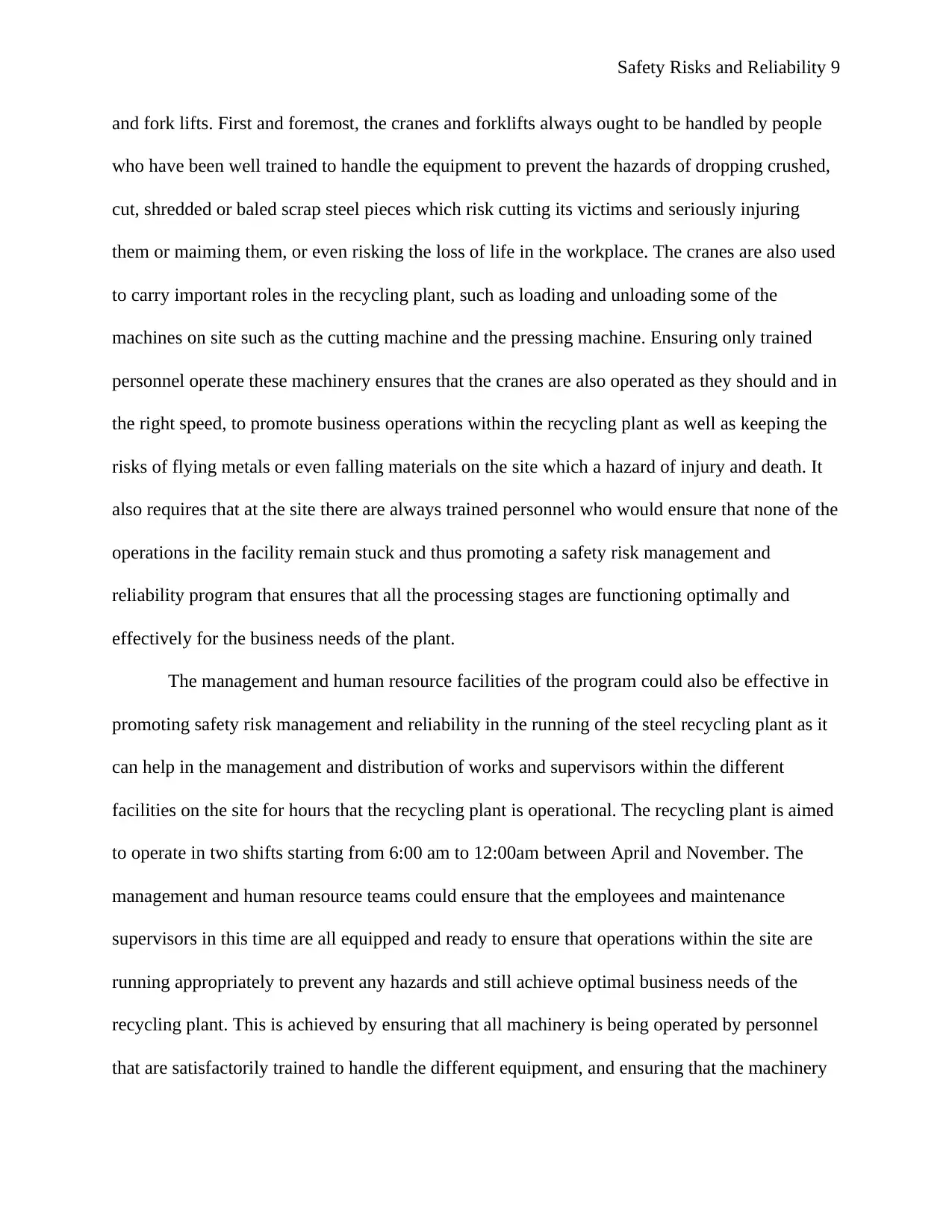
Safety Risks and Reliability 9
and fork lifts. First and foremost, the cranes and forklifts always ought to be handled by people
who have been well trained to handle the equipment to prevent the hazards of dropping crushed,
cut, shredded or baled scrap steel pieces which risk cutting its victims and seriously injuring
them or maiming them, or even risking the loss of life in the workplace. The cranes are also used
to carry important roles in the recycling plant, such as loading and unloading some of the
machines on site such as the cutting machine and the pressing machine. Ensuring only trained
personnel operate these machinery ensures that the cranes are also operated as they should and in
the right speed, to promote business operations within the recycling plant as well as keeping the
risks of flying metals or even falling materials on the site which a hazard of injury and death. It
also requires that at the site there are always trained personnel who would ensure that none of the
operations in the facility remain stuck and thus promoting a safety risk management and
reliability program that ensures that all the processing stages are functioning optimally and
effectively for the business needs of the plant.
The management and human resource facilities of the program could also be effective in
promoting safety risk management and reliability in the running of the steel recycling plant as it
can help in the management and distribution of works and supervisors within the different
facilities on the site for hours that the recycling plant is operational. The recycling plant is aimed
to operate in two shifts starting from 6:00 am to 12:00am between April and November. The
management and human resource teams could ensure that the employees and maintenance
supervisors in this time are all equipped and ready to ensure that operations within the site are
running appropriately to prevent any hazards and still achieve optimal business needs of the
recycling plant. This is achieved by ensuring that all machinery is being operated by personnel
that are satisfactorily trained to handle the different equipment, and ensuring that the machinery
and fork lifts. First and foremost, the cranes and forklifts always ought to be handled by people
who have been well trained to handle the equipment to prevent the hazards of dropping crushed,
cut, shredded or baled scrap steel pieces which risk cutting its victims and seriously injuring
them or maiming them, or even risking the loss of life in the workplace. The cranes are also used
to carry important roles in the recycling plant, such as loading and unloading some of the
machines on site such as the cutting machine and the pressing machine. Ensuring only trained
personnel operate these machinery ensures that the cranes are also operated as they should and in
the right speed, to promote business operations within the recycling plant as well as keeping the
risks of flying metals or even falling materials on the site which a hazard of injury and death. It
also requires that at the site there are always trained personnel who would ensure that none of the
operations in the facility remain stuck and thus promoting a safety risk management and
reliability program that ensures that all the processing stages are functioning optimally and
effectively for the business needs of the plant.
The management and human resource facilities of the program could also be effective in
promoting safety risk management and reliability in the running of the steel recycling plant as it
can help in the management and distribution of works and supervisors within the different
facilities on the site for hours that the recycling plant is operational. The recycling plant is aimed
to operate in two shifts starting from 6:00 am to 12:00am between April and November. The
management and human resource teams could ensure that the employees and maintenance
supervisors in this time are all equipped and ready to ensure that operations within the site are
running appropriately to prevent any hazards and still achieve optimal business needs of the
recycling plant. This is achieved by ensuring that all machinery is being operated by personnel
that are satisfactorily trained to handle the different equipment, and ensuring that the machinery
⊘ This is a preview!⊘
Do you want full access?
Subscribe today to unlock all pages.

Trusted by 1+ million students worldwide
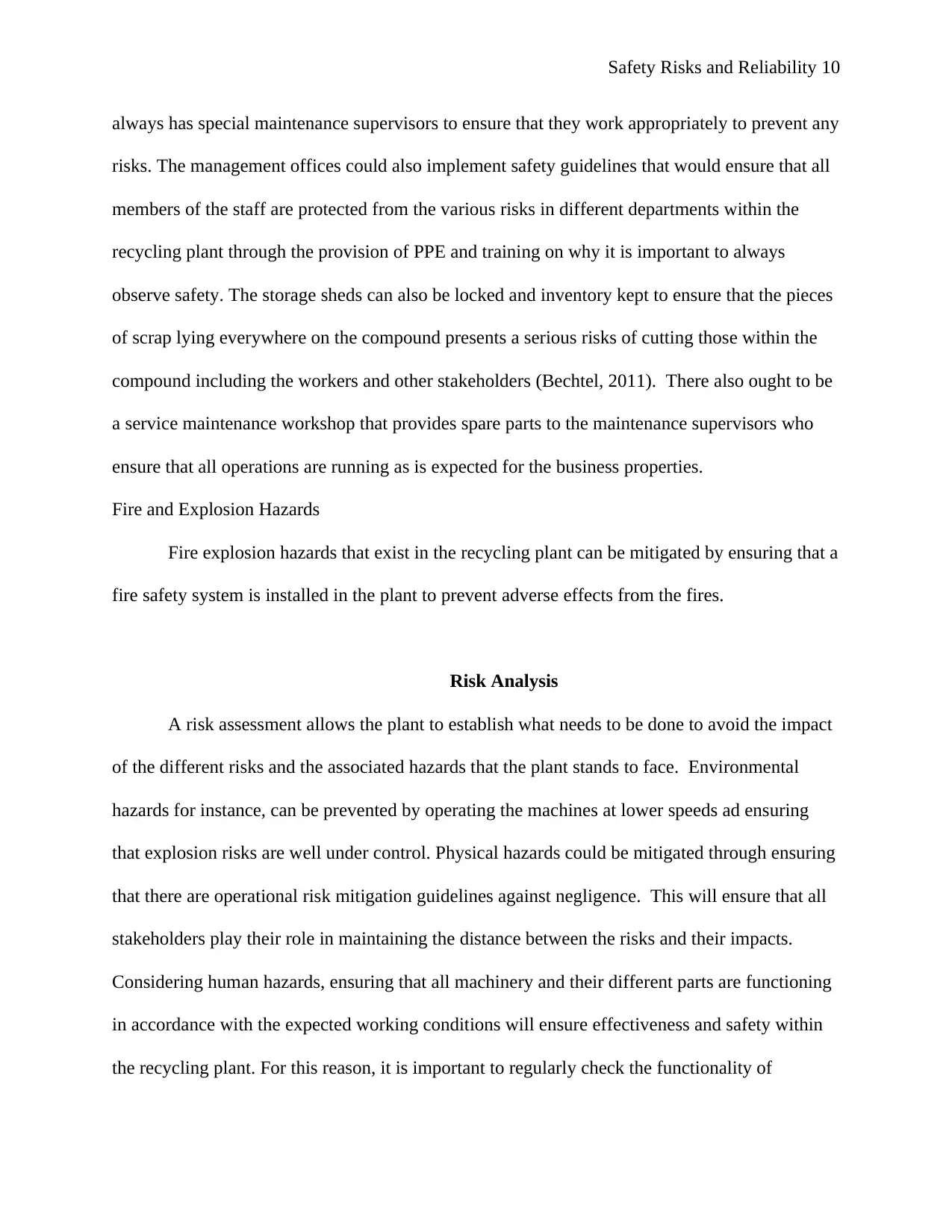
Safety Risks and Reliability 10
always has special maintenance supervisors to ensure that they work appropriately to prevent any
risks. The management offices could also implement safety guidelines that would ensure that all
members of the staff are protected from the various risks in different departments within the
recycling plant through the provision of PPE and training on why it is important to always
observe safety. The storage sheds can also be locked and inventory kept to ensure that the pieces
of scrap lying everywhere on the compound presents a serious risks of cutting those within the
compound including the workers and other stakeholders (Bechtel, 2011). There also ought to be
a service maintenance workshop that provides spare parts to the maintenance supervisors who
ensure that all operations are running as is expected for the business properties.
Fire and Explosion Hazards
Fire explosion hazards that exist in the recycling plant can be mitigated by ensuring that a
fire safety system is installed in the plant to prevent adverse effects from the fires.
Risk Analysis
A risk assessment allows the plant to establish what needs to be done to avoid the impact
of the different risks and the associated hazards that the plant stands to face. Environmental
hazards for instance, can be prevented by operating the machines at lower speeds ad ensuring
that explosion risks are well under control. Physical hazards could be mitigated through ensuring
that there are operational risk mitigation guidelines against negligence. This will ensure that all
stakeholders play their role in maintaining the distance between the risks and their impacts.
Considering human hazards, ensuring that all machinery and their different parts are functioning
in accordance with the expected working conditions will ensure effectiveness and safety within
the recycling plant. For this reason, it is important to regularly check the functionality of
always has special maintenance supervisors to ensure that they work appropriately to prevent any
risks. The management offices could also implement safety guidelines that would ensure that all
members of the staff are protected from the various risks in different departments within the
recycling plant through the provision of PPE and training on why it is important to always
observe safety. The storage sheds can also be locked and inventory kept to ensure that the pieces
of scrap lying everywhere on the compound presents a serious risks of cutting those within the
compound including the workers and other stakeholders (Bechtel, 2011). There also ought to be
a service maintenance workshop that provides spare parts to the maintenance supervisors who
ensure that all operations are running as is expected for the business properties.
Fire and Explosion Hazards
Fire explosion hazards that exist in the recycling plant can be mitigated by ensuring that a
fire safety system is installed in the plant to prevent adverse effects from the fires.
Risk Analysis
A risk assessment allows the plant to establish what needs to be done to avoid the impact
of the different risks and the associated hazards that the plant stands to face. Environmental
hazards for instance, can be prevented by operating the machines at lower speeds ad ensuring
that explosion risks are well under control. Physical hazards could be mitigated through ensuring
that there are operational risk mitigation guidelines against negligence. This will ensure that all
stakeholders play their role in maintaining the distance between the risks and their impacts.
Considering human hazards, ensuring that all machinery and their different parts are functioning
in accordance with the expected working conditions will ensure effectiveness and safety within
the recycling plant. For this reason, it is important to regularly check the functionality of
Paraphrase This Document
Need a fresh take? Get an instant paraphrase of this document with our AI Paraphraser
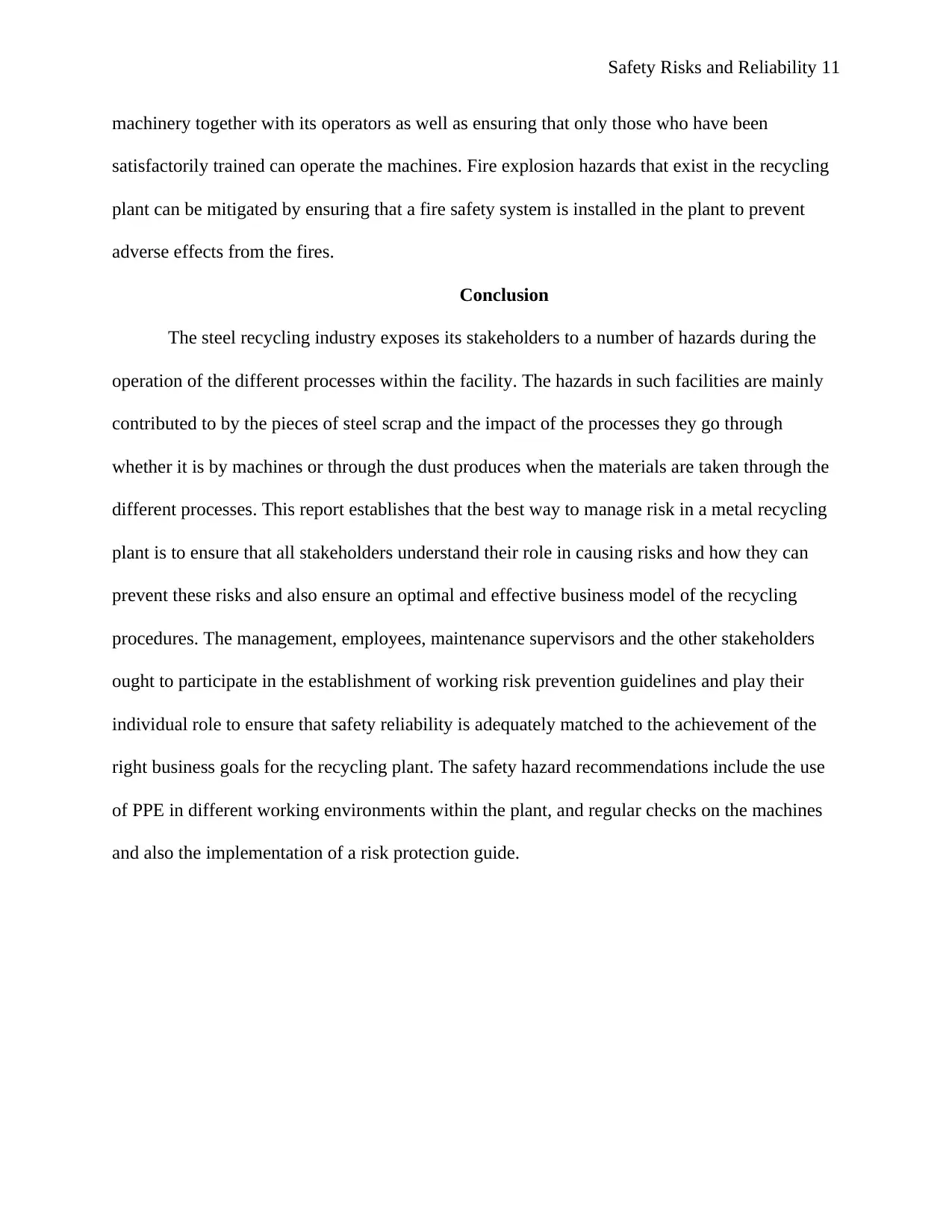
Safety Risks and Reliability 11
machinery together with its operators as well as ensuring that only those who have been
satisfactorily trained can operate the machines. Fire explosion hazards that exist in the recycling
plant can be mitigated by ensuring that a fire safety system is installed in the plant to prevent
adverse effects from the fires.
Conclusion
The steel recycling industry exposes its stakeholders to a number of hazards during the
operation of the different processes within the facility. The hazards in such facilities are mainly
contributed to by the pieces of steel scrap and the impact of the processes they go through
whether it is by machines or through the dust produces when the materials are taken through the
different processes. This report establishes that the best way to manage risk in a metal recycling
plant is to ensure that all stakeholders understand their role in causing risks and how they can
prevent these risks and also ensure an optimal and effective business model of the recycling
procedures. The management, employees, maintenance supervisors and the other stakeholders
ought to participate in the establishment of working risk prevention guidelines and play their
individual role to ensure that safety reliability is adequately matched to the achievement of the
right business goals for the recycling plant. The safety hazard recommendations include the use
of PPE in different working environments within the plant, and regular checks on the machines
and also the implementation of a risk protection guide.
machinery together with its operators as well as ensuring that only those who have been
satisfactorily trained can operate the machines. Fire explosion hazards that exist in the recycling
plant can be mitigated by ensuring that a fire safety system is installed in the plant to prevent
adverse effects from the fires.
Conclusion
The steel recycling industry exposes its stakeholders to a number of hazards during the
operation of the different processes within the facility. The hazards in such facilities are mainly
contributed to by the pieces of steel scrap and the impact of the processes they go through
whether it is by machines or through the dust produces when the materials are taken through the
different processes. This report establishes that the best way to manage risk in a metal recycling
plant is to ensure that all stakeholders understand their role in causing risks and how they can
prevent these risks and also ensure an optimal and effective business model of the recycling
procedures. The management, employees, maintenance supervisors and the other stakeholders
ought to participate in the establishment of working risk prevention guidelines and play their
individual role to ensure that safety reliability is adequately matched to the achievement of the
right business goals for the recycling plant. The safety hazard recommendations include the use
of PPE in different working environments within the plant, and regular checks on the machines
and also the implementation of a risk protection guide.
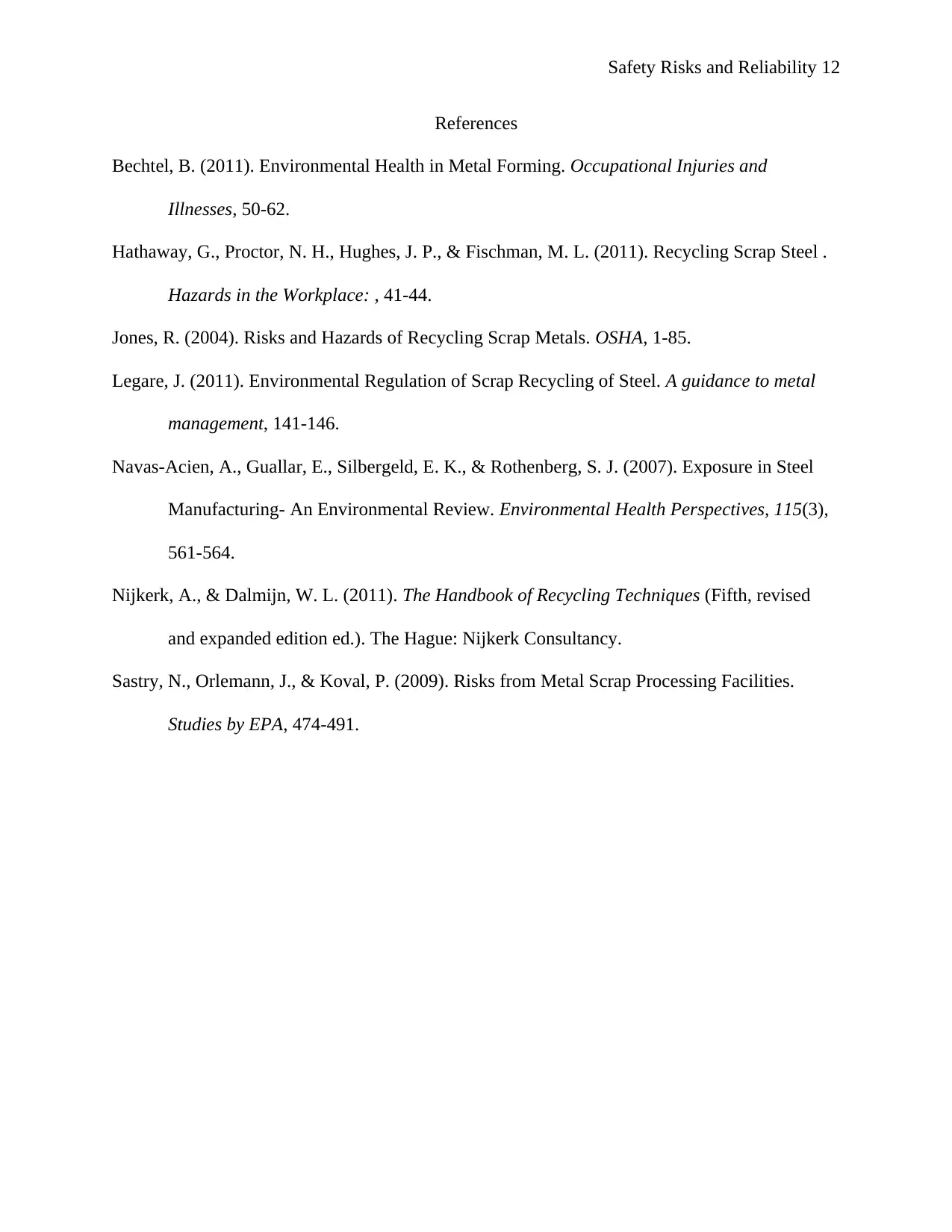
Safety Risks and Reliability 12
References
Bechtel, B. (2011). Environmental Health in Metal Forming. Occupational Injuries and
Illnesses, 50-62.
Hathaway, G., Proctor, N. H., Hughes, J. P., & Fischman, M. L. (2011). Recycling Scrap Steel .
Hazards in the Workplace: , 41-44.
Jones, R. (2004). Risks and Hazards of Recycling Scrap Metals. OSHA, 1-85.
Legare, J. (2011). Environmental Regulation of Scrap Recycling of Steel. A guidance to metal
management, 141-146.
Navas-Acien, A., Guallar, E., Silbergeld, E. K., & Rothenberg, S. J. (2007). Exposure in Steel
Manufacturing- An Environmental Review. Environmental Health Perspectives, 115(3),
561-564.
Nijkerk, A., & Dalmijn, W. L. (2011). The Handbook of Recycling Techniques (Fifth, revised
and expanded edition ed.). The Hague: Nijkerk Consultancy.
Sastry, N., Orlemann, J., & Koval, P. (2009). Risks from Metal Scrap Processing Facilities.
Studies by EPA, 474-491.
References
Bechtel, B. (2011). Environmental Health in Metal Forming. Occupational Injuries and
Illnesses, 50-62.
Hathaway, G., Proctor, N. H., Hughes, J. P., & Fischman, M. L. (2011). Recycling Scrap Steel .
Hazards in the Workplace: , 41-44.
Jones, R. (2004). Risks and Hazards of Recycling Scrap Metals. OSHA, 1-85.
Legare, J. (2011). Environmental Regulation of Scrap Recycling of Steel. A guidance to metal
management, 141-146.
Navas-Acien, A., Guallar, E., Silbergeld, E. K., & Rothenberg, S. J. (2007). Exposure in Steel
Manufacturing- An Environmental Review. Environmental Health Perspectives, 115(3),
561-564.
Nijkerk, A., & Dalmijn, W. L. (2011). The Handbook of Recycling Techniques (Fifth, revised
and expanded edition ed.). The Hague: Nijkerk Consultancy.
Sastry, N., Orlemann, J., & Koval, P. (2009). Risks from Metal Scrap Processing Facilities.
Studies by EPA, 474-491.
⊘ This is a preview!⊘
Do you want full access?
Subscribe today to unlock all pages.

Trusted by 1+ million students worldwide
1 out of 12
Your All-in-One AI-Powered Toolkit for Academic Success.
+13062052269
info@desklib.com
Available 24*7 on WhatsApp / Email
![[object Object]](/_next/static/media/star-bottom.7253800d.svg)
Unlock your academic potential
Copyright © 2020–2025 A2Z Services. All Rights Reserved. Developed and managed by ZUCOL.

